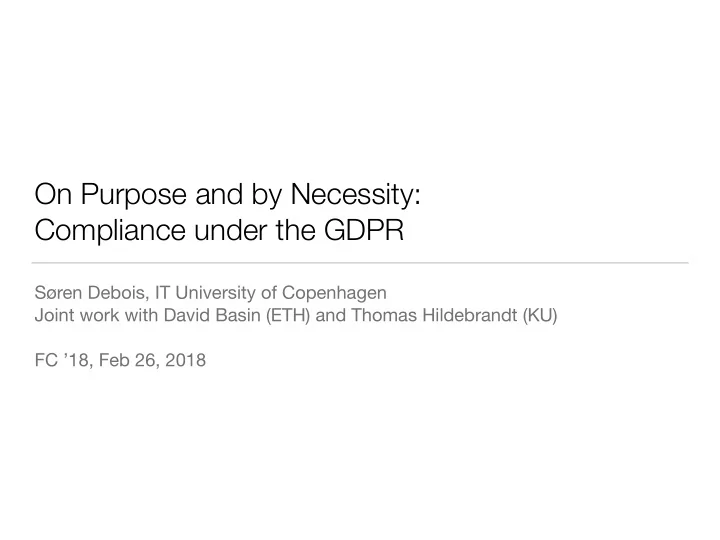

On Purpose and by Necessity: Compliance under the GDPR Søren Debois, IT University of Copenhagen Joint work with David Basin (ETH) and Thomas Hildebrandt (KU) FC ’18, Feb 26, 2018
General Data Protection Regulation May 25, 2018
GDPR • EU G eneral D ata P rotection R egulation • In force May 25, 2018. • Teeth! Fines up to 20 million EUR or 4% of world-wide turnover , whichever is higher [9, Article 83, §5] • Long list of mandates: Right to be forgotten, Right of access, Right of rectification, Right to erasure, Right to restrict processing, Right of data portability, Obligation to inform, Right to not be evaluated on the basis of automated processing, … • In particular …
GDPR • Purpose limitation [9, Article 5, §1(b)]: “[Personal data shall be] collected for specified, explicit and legitimate purposes and not further processed in a manner that is incompatible with those purposes; [...]” • Data minimisation [9, Article 5, §1(c)]: “[Personal data shall be] adequate, relevant and limited to what is necessary in relation to the purposes for which they are processed [...] ” • Consent [9, Recital (32)]: “Consent should cover all processing activities carried out for the same purpose or purposes.”
Automatic Audits? • Not at present • Purpose limitation, connecting purpose to data, is beyond computers—e.g., is a text “advertising” or “political propaganda”? • Data minimisation is beyond computers—do we really need your images to fulfil grocery orders? • Proposal: Computer- supported audits.
GDPR That is, the GDPR requires that personal data can only: 1. be collected for a purpose, 2. to which the user has consented, and 3. be necessary to achieve that purpose; 4. moreover the collected data must be deleted when it is no longer necessary for any purpose.
GDPR That is, the GDPR requires that personal data can only: ! s i h t r 1. be collected for a purpose, o f y d a e 2. to which the user has consented, and r t o n y 3. be necessary to achieve that purpose; l l a r e n e g 4. moreover the collected data must be deleted when it is e r no longer necessary for any purpose. a e W
Where is the purpose? It’s not a programming concept
Business Processes • E.g., sales, marketing, procurement, order fulfillment, loan processing, … • “a structured, measured set of activities designed to produce a specific output for a particular customer or market. A process is thus a specific ordering of work activities across time and space […]” [Davenport ’94] • “specific output for […] customer” ~ “purpose” • But: data collected in one process (for one purpose) may migrate to other processes
Process collections
What is a “Data class”? • You give consent for me using your <data class> for <purpose>. • Examples: Name, address, credit card. • Also examples: Personal information, payment details, order history. • Non-examples: Specific data. “Søren”, “Thomas”, and “David” are not data classes.
Implementation(s) (1) Decomposing Process model collection compliance (2) 1. Implementation must conform to process model (3) Privacy policy 2. Process model must conform to privacy policy 3. Process model must conform to (4) the GDPR 4. Privacy policy must conform to the GDPR GDPR
Where do we find process collections? Requirements specifications, process models (BPMN), implementation artifacts
Retailer example BPMN
Retailer Register customer example credit card number customer Purchase Mass Marketing order Targeted Marketing profile BPMN
Retailer Register customer example Formalising privacy policies credit card number customer Purchase Mass Marketing order “We collect your customer information, order history, and profile, and use them to Targeted Marketing send you targeted advertising” profile BPMN
Register customer What’s wrong with this picture? credit card number customer Purpose limitation: Purchase Mass Marketing Can’t collect “photo” during “Purchase” process/purpose without use. order photo May detect automatically Targeted Marketing profile
Related work • Purpose-based access control, e.g.: Milan Petkovic, Davide Prandi, and Nicola Zannone. Purpose Control: Did You Process the Data for the Intended Purpose? In Secure Data Management, LNCS 6933, pp. 145–168. Springer, 2011. • [Privacy-aware / Purpose-aware] role based access control, e.g.: Ni, Bertino, Lobo, Brodie, Karat, Karat, and Trombeta. Privacy-aware Role-based Access Control. ACM Transactions on Information System Security 13(3):24:1–24:31, July 2010.
Conclusion • Regulations (GDPR) require consent to purposes • How do we audit a computer system’s adherence to a purpose? • Business Process Models, process model collections! • Connecting the formal (process model, implementation) to the informal (purpose, privacy policy, unnecessary data)
Thank you! Søren Debois, IT University of Copenhagen Joint work with David Basin and Thomas Hildebrandt FC ’18, Feb 26, 2018
Recommend
More recommend